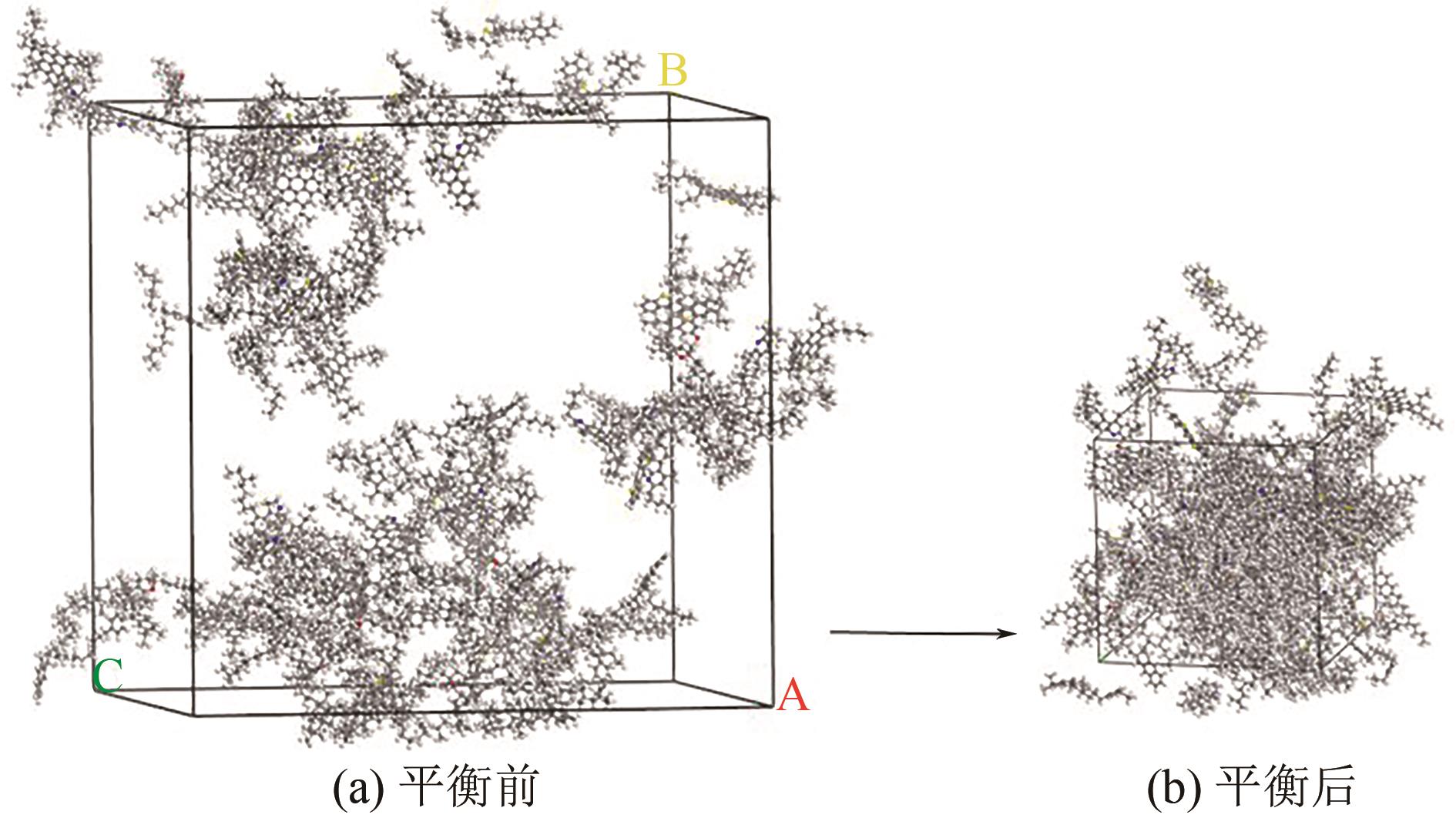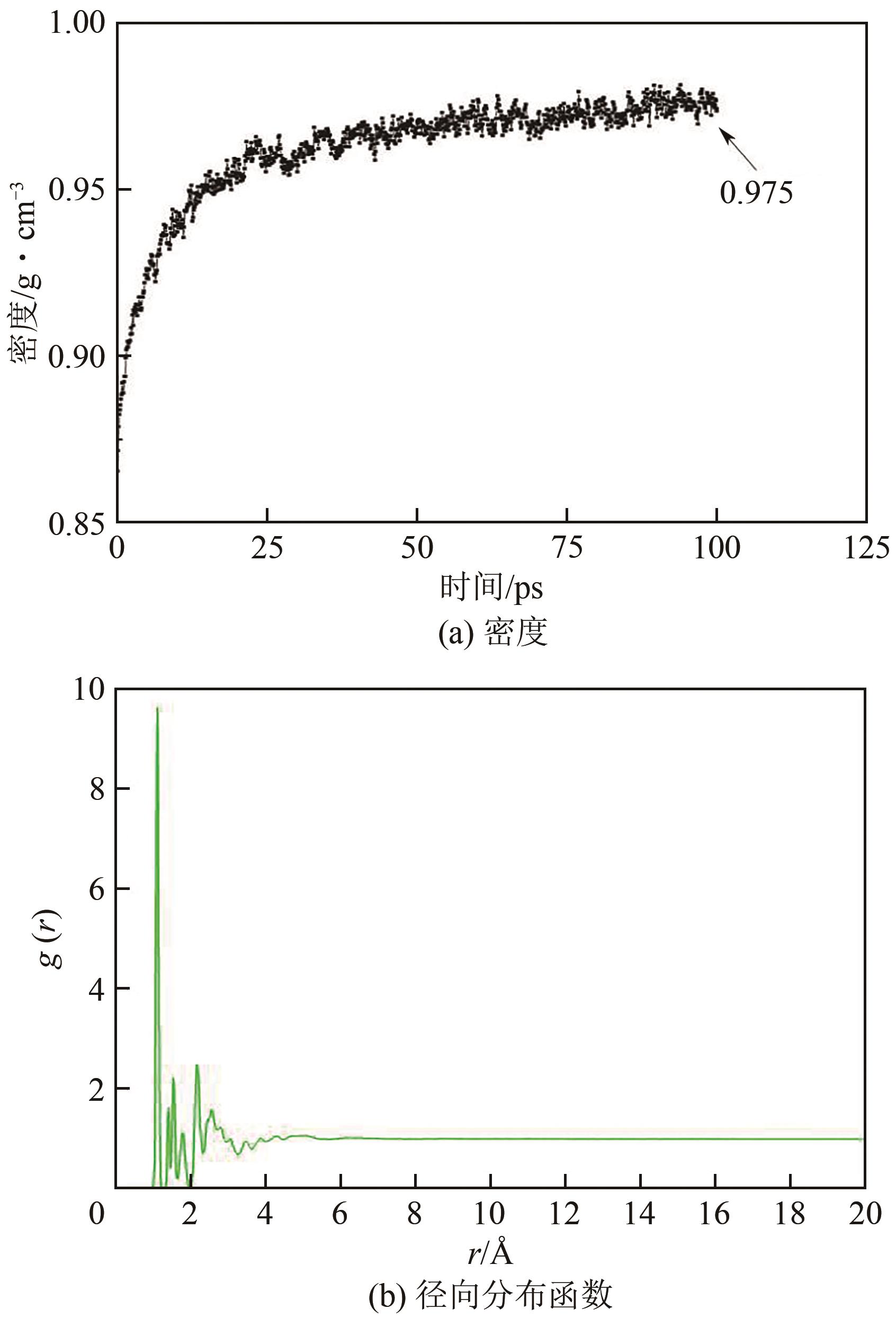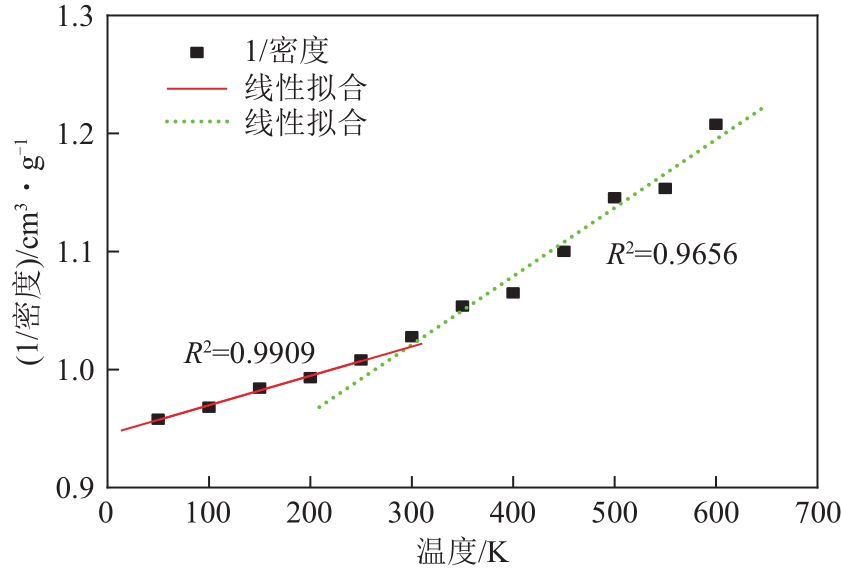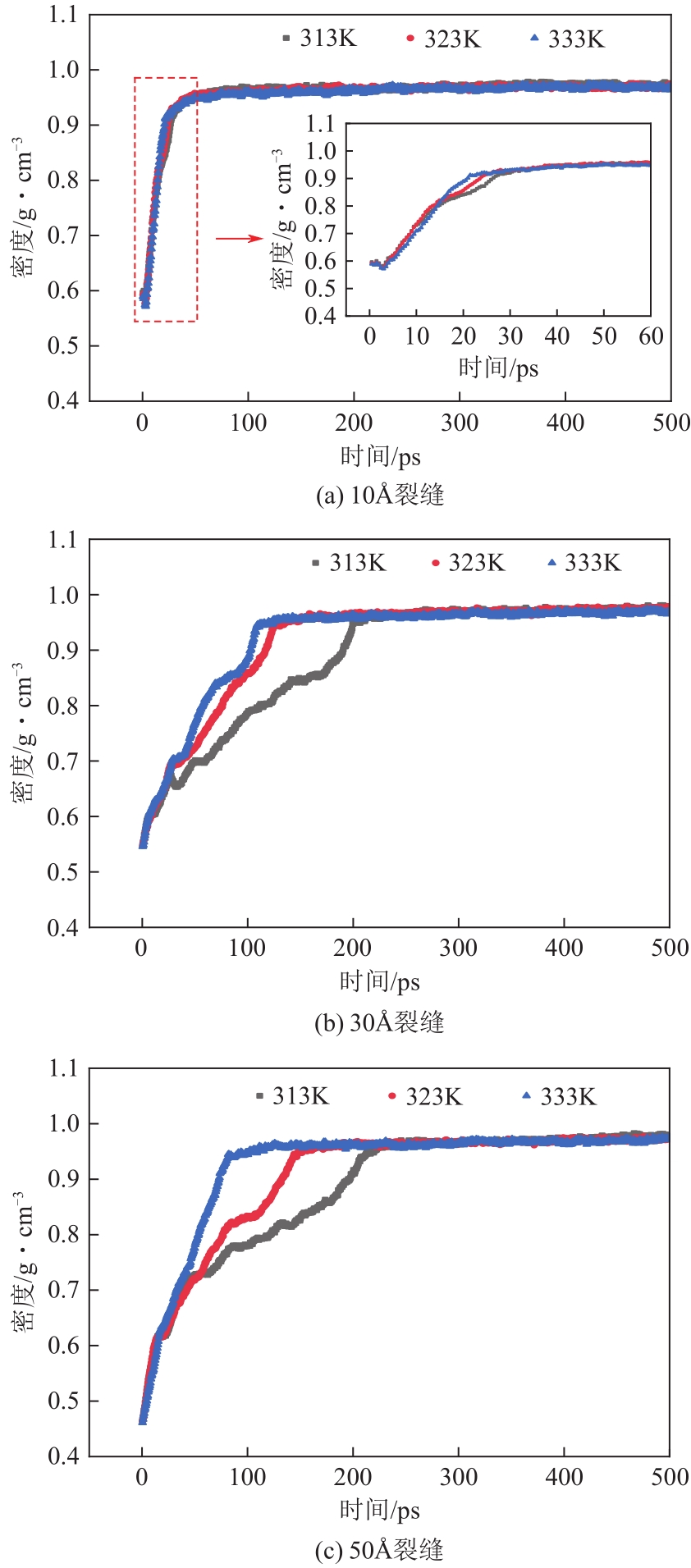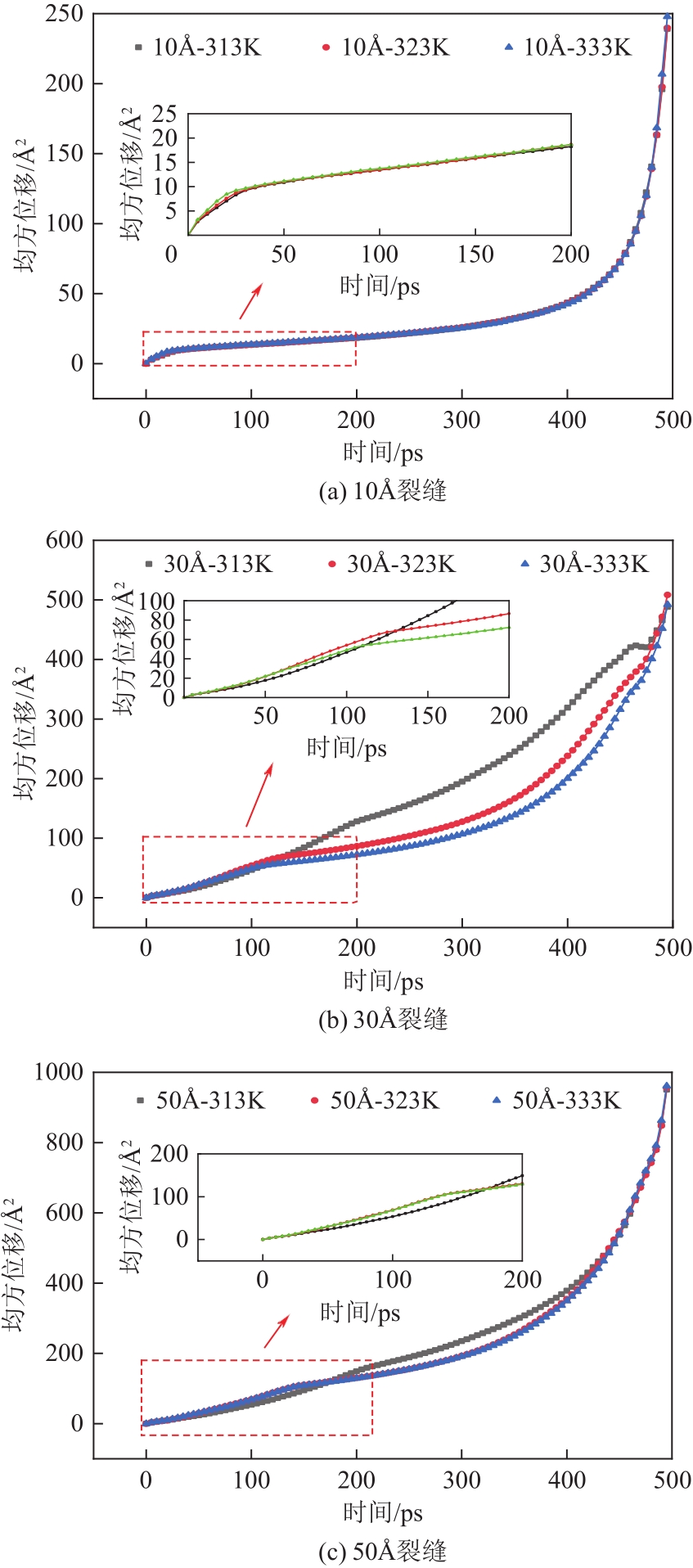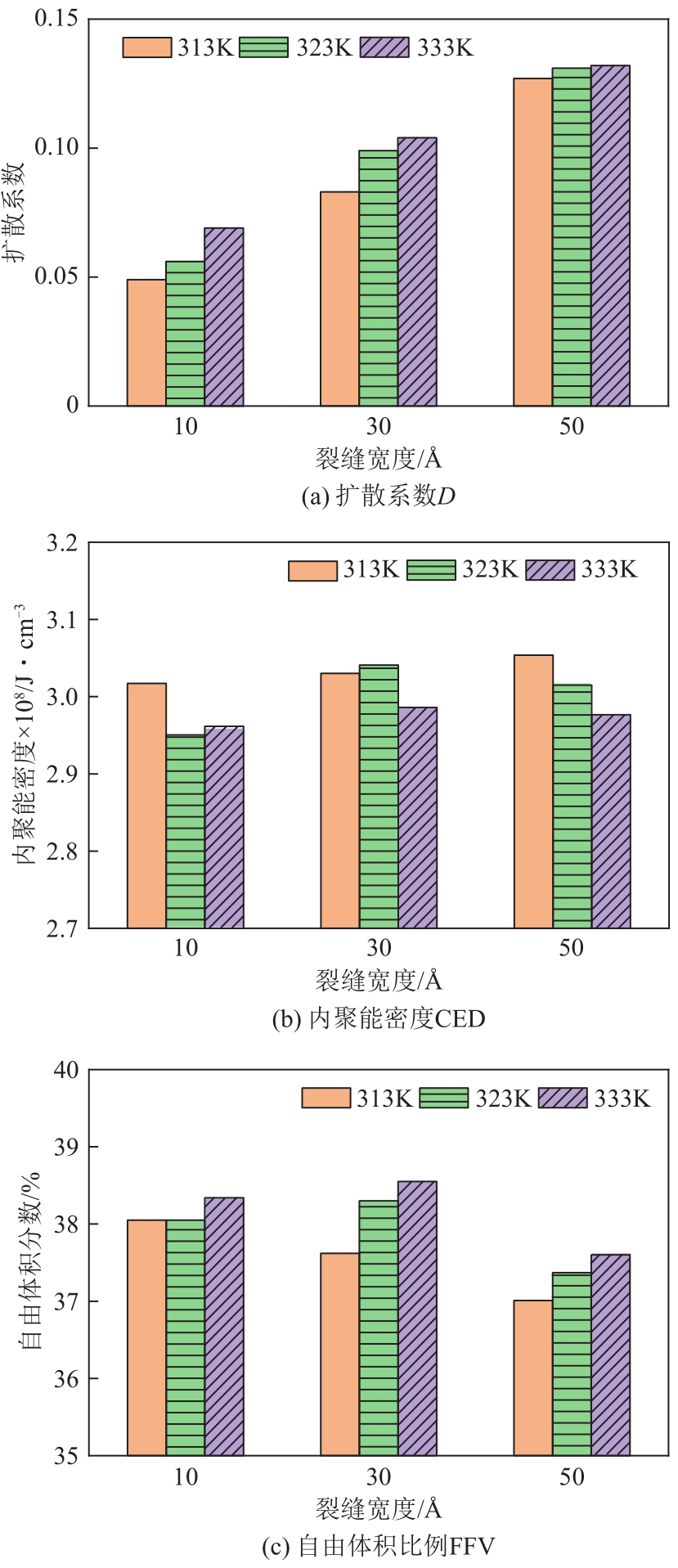Chemical Industry and Engineering Progress ›› 2023, Vol. 42 ›› Issue (6): 3147-3156.DOI: 10.16085/j.issn.1000-6613.2022-1520
• Materials science and technology • Previous Articles Next Articles
Molecular simulation of self-healing behavior of asphalt under different crack damage and healing temperature
ZHAO Yi1,2( ), YANG Zhen3, ZHANG Xinwei4, WANG Gang4, YANG Xuan5
), YANG Zhen3, ZHANG Xinwei4, WANG Gang4, YANG Xuan5
- 1.National & Local Joint Engineering Laboratory of Traffic Civil Engineering Materials, Chongqing Jiaotong University, Chongqing 400074, China
2.School of Materials Science and Engineering, Chongqing Jiaotong University, Chongqing 400074, China
3.School of Civil Engineering, Chongqing Jiaotong University, Chongqing 400074, China
4.CSCEC Road and Bridge Group Co. , Ltd. , Shijiazhuang 050001, Hebei, China
5.School of Transportation Science and Engineering, Harbin Institute of Technology, Harbin 150090, Heilongjiang, China
-
Received:2022-08-17Revised:2022-09-29Online:2023-06-29Published:2023-06-25 -
Contact:ZHAO Yi
不同裂缝损伤和愈合温度条件下沥青自愈合行为的分子模拟
- 1.重庆交通大学交通土建工程材料国家地方联合工程实验室,重庆 400074
2.重庆交通大学材料科学与 工程学院,重庆 400074
3.重庆交通大学土木工程学院,重庆 400074
4.中建路桥集团有限公司,河北 石家庄 050001
5.哈尔滨工业大学交通科学与工程学院,黑龙江 哈尔滨 150090
-
通讯作者:赵毅 -
作者简介:赵毅(1980—),男,教授,硕士生导师,研究方向为高性能沥青材料。E-mail:1585513635@qq.com。 -
基金资助:重庆市研究生联合培养基地建设项目(JDLHPYJD2021011);重庆交通大学交通土建工程材料国家地方联合工程实验室开放基金(LHSYS-2021-002);河北省交通运输厅科技项目(QC2018-3)
CLC Number:
Cite this article
ZHAO Yi, YANG Zhen, ZHANG Xinwei, WANG Gang, YANG Xuan. Molecular simulation of self-healing behavior of asphalt under different crack damage and healing temperature[J]. Chemical Industry and Engineering Progress, 2023, 42(6): 3147-3156.
赵毅, 杨臻, 张新为, 王刚, 杨旋. 不同裂缝损伤和愈合温度条件下沥青自愈合行为的分子模拟[J]. 化工进展, 2023, 42(6): 3147-3156.
share this article
Add to citation manager EndNote|Ris|BibTeX
URL: https://hgjz.cip.com.cn/EN/10.16085/j.issn.1000-6613.2022-1520
| 项目 | 针入度(25℃、100g、5s)/0.1mm | 延度(5cm/min、15℃)/cm | 软化点/℃ |
|---|---|---|---|
| 70#基质沥青 | 65 | 130 | 49 |
| 技术标准 | 60~80 | >100 | ≥ 45 |
| 项目 | 针入度(25℃、100g、5s)/0.1mm | 延度(5cm/min、15℃)/cm | 软化点/℃ |
|---|---|---|---|
| 70#基质沥青 | 65 | 130 | 49 |
| 技术标准 | 60~80 | >100 | ≥ 45 |
| 项目 | 组分含量/% | |||
|---|---|---|---|---|
| 胶质R | 沥青质As | 芳香分Ar | 饱和分S | |
| 70#基质沥青 | 37.71 | 22.40 | 22.39 | 17.50 |
| 技术要求 | 31~55 | >10 | 21~47 | 12~27 |
| 项目 | 组分含量/% | |||
|---|---|---|---|---|
| 胶质R | 沥青质As | 芳香分Ar | 饱和分S | |
| 70#基质沥青 | 37.71 | 22.40 | 22.39 | 17.50 |
| 技术要求 | 31~55 | >10 | 21~47 | 12~27 |
| 组分 | 分子 | 分子名称 | 分子式 | 分子量 | 原子数 | 代码 |
|---|---|---|---|---|---|---|
| 胶质 | 胶质A | Pyridinonhopane | C36H57N | 503.8 | 94 | a |
| 胶质B | Quinolinohopane | C40H59N | 553.9 | 100 | b | |
| 胶质C | Trimethylbenzeneoxane | C29H50O | 414.7 | 80 | c | |
| 胶质D | Benzobisbenzothiophene | C18H10S2 | 290.4 | 30 | d | |
| 胶质E | Thioisorenieratane | C40H60S | 573.0 | 101 | e | |
| 沥青质 | 沥青质A | Asphaltene-phenol | C42H54O | 574.9 | 97 | f |
| 沥青质B | Asphaltene-pyrrole | C66H81N | 888.4 | 148 | g | |
| 沥青质C | Asphaltene-thiophene | C51H62S | 707.1 | 114 | h | |
| 芳香分 | 芳香分A | PHPN | C35H44 | 464.7 | 79 | i |
| 芳香分B | DOCHN | C30H46 | 406.7 | 76 | j | |
| 饱和分 | 饱和分A | Squalane | C30H62 | 422.8 | 92 | k |
| 饱和分B | Hopane | C35H62 | 482.9 | 97 | l |
| 组分 | 分子 | 分子名称 | 分子式 | 分子量 | 原子数 | 代码 |
|---|---|---|---|---|---|---|
| 胶质 | 胶质A | Pyridinonhopane | C36H57N | 503.8 | 94 | a |
| 胶质B | Quinolinohopane | C40H59N | 553.9 | 100 | b | |
| 胶质C | Trimethylbenzeneoxane | C29H50O | 414.7 | 80 | c | |
| 胶质D | Benzobisbenzothiophene | C18H10S2 | 290.4 | 30 | d | |
| 胶质E | Thioisorenieratane | C40H60S | 573.0 | 101 | e | |
| 沥青质 | 沥青质A | Asphaltene-phenol | C42H54O | 574.9 | 97 | f |
| 沥青质B | Asphaltene-pyrrole | C66H81N | 888.4 | 148 | g | |
| 沥青质C | Asphaltene-thiophene | C51H62S | 707.1 | 114 | h | |
| 芳香分 | 芳香分A | PHPN | C35H44 | 464.7 | 79 | i |
| 芳香分B | DOCHN | C30H46 | 406.7 | 76 | j | |
| 饱和分 | 饱和分A | Squalane | C30H62 | 422.8 | 92 | k |
| 饱和分B | Hopane | C35H62 | 482.9 | 97 | l |
| 组分 | 分子 | 分子量 | 原子数 | 模型 分子数 | 质量 分数/% | 模型 原子数 | 模型 比例/% |
|---|---|---|---|---|---|---|---|
| 胶质 | A | 503.9 | 94 | 9 | 7.80 | 846 | 37.51 |
| B | 533.9 | 100 | 9 | 8.54 | 900 | ||
| C | 414.7 | 80 | 10 | 6.39 | 800 | ||
| D | 290.4 | 30 | 10 | 4.97 | 300 | ||
| E | 573 | 101 | 10 | 9.81 | 1010 | ||
| 沥青质 | A | 574.9 | 97 | 6 | 5.91 | 582 | 22.31 |
| B | 888.4 | 148 | 6 | 9.13 | 888 | ||
| C | 707.1 | 114 | 6 | 7.27 | 684 | ||
| 芳香分 | A | 464.7 | 79 | 15 | 11.94 | 1185 | 22.39 |
| B | 406.7 | 76 | 15 | 10.45 | 1140 | ||
| 饱和分 | A | 422.8 | 92 | 12 | 8.69 | 1104 | 17.79 |
| B | 482.9 | 97 | 11 | 9.10 | 1067 | ||
| 总和 | — | — | — | 119 | 100 | 10506 | 100 |
| 组分 | 分子 | 分子量 | 原子数 | 模型 分子数 | 质量 分数/% | 模型 原子数 | 模型 比例/% |
|---|---|---|---|---|---|---|---|
| 胶质 | A | 503.9 | 94 | 9 | 7.80 | 846 | 37.51 |
| B | 533.9 | 100 | 9 | 8.54 | 900 | ||
| C | 414.7 | 80 | 10 | 6.39 | 800 | ||
| D | 290.4 | 30 | 10 | 4.97 | 300 | ||
| E | 573 | 101 | 10 | 9.81 | 1010 | ||
| 沥青质 | A | 574.9 | 97 | 6 | 5.91 | 582 | 22.31 |
| B | 888.4 | 148 | 6 | 9.13 | 888 | ||
| C | 707.1 | 114 | 6 | 7.27 | 684 | ||
| 芳香分 | A | 464.7 | 79 | 15 | 11.94 | 1185 | 22.39 |
| B | 406.7 | 76 | 15 | 10.45 | 1140 | ||
| 饱和分 | A | 422.8 | 92 | 12 | 8.69 | 1104 | 17.79 |
| B | 482.9 | 97 | 11 | 9.10 | 1067 | ||
| 总和 | — | — | — | 119 | 100 | 10506 | 100 |
| 沥青种类 | CED/J·cm-3 | SP/(J·cm-3)1/2 |
|---|---|---|
| 70#基质沥青 | 254 | 15.9 |
| 参考值 | 234~529 | 13.3~22.5[ |
| 沥青种类 | CED/J·cm-3 | SP/(J·cm-3)1/2 |
|---|---|---|
| 70#基质沥青 | 254 | 15.9 |
| 参考值 | 234~529 | 13.3~22.5[ |
| 裂缝宽度/Å | 温度/K | 自由体积 | 原子占用体积 | FFV/% |
|---|---|---|---|---|
| 10 | 313 | 77267.19 | 125801.34 | 38.05 |
| 323 | 77247.33 | 125769.34 | 38.05 | |
| 333 | 78227.10 | 125807.38 | 38.34 | |
| 30 | 313 | 75845.83 | 125785.55 | 37.62 |
| 323 | 78112.28 | 125814.18 | 38.30 | |
| 333 | 78929.77 | 125797.60 | 38.55 | |
| 50 | 313 | 73915.30 | 125800.50 | 37.01 |
| 323 | 75050.53 | 125767.53 | 37.37 | |
| 333 | 75810.68 | 125808.70 | 37.60 | |
| 70#(单晶胞) | — | 54694.88 | 62944.17 | 46.49 |
| 裂缝宽度/Å | 温度/K | 自由体积 | 原子占用体积 | FFV/% |
|---|---|---|---|---|
| 10 | 313 | 77267.19 | 125801.34 | 38.05 |
| 323 | 77247.33 | 125769.34 | 38.05 | |
| 333 | 78227.10 | 125807.38 | 38.34 | |
| 30 | 313 | 75845.83 | 125785.55 | 37.62 |
| 323 | 78112.28 | 125814.18 | 38.30 | |
| 333 | 78929.77 | 125797.60 | 38.55 | |
| 50 | 313 | 73915.30 | 125800.50 | 37.01 |
| 323 | 75050.53 | 125767.53 | 37.37 | |
| 333 | 75810.68 | 125808.70 | 37.60 | |
| 70#(单晶胞) | — | 54694.88 | 62944.17 | 46.49 |
| 1 | XIANG Haonan, HE Zhaoyi, TANG Haojie, et al. Healing behavior of thermo-oxygen aged asphalt based on molecular dynamics simulations[J]. Construction and Building Materials, 2022, 349: 128740. |
| 2 | 裴建新. 沥青裂缝自修复微胶囊的制备与表征[J]. 化工进展, 2016, 35(9): 2898-2904. |
| PEI Jianxin. Preparation and properties of self-healing microcapsule for asphalt crack[J]. Chemical Industry and Engineering Progress, 2016, 35(9): 2898-2904. | |
| 3 | 徐建平, 赵毅, 梁乃兴, 等. 基于疲劳累积损伤的高模量沥青路面使用寿命预估[J]. 长安大学学报(自然科学版), 2018, 38(2): 26-33. |
| XU Jianping, ZHAO Yi, LIANG Naixing, et al. Life prediction of high modulus asphalt pavement based on fatigue cumulative damage[J]. Journal of Chang'an University (Natural Science Edition), 2018, 38(2): 26-33. | |
| 4 | SUN Daquan, SUN Guoqiang, ZHU Xingyi, et al. A comprehensive review on self-healing of asphalt materials: Mechanism, model, characterization and enhancement[J]. Advances in Colloid and Interface Science, 2018, 256: 65-93. |
| 5 | HE Liang, LI Guannan, Songtao LYU, et al. Self-healing behavior of asphalt system based on molecular dynamics simulation[J]. Construction and Building Materials, 2020, 254: 119225. |
| 6 | GREENFIELD M L. Molecular modelling and simulation of asphaltenes and bituminous materials[J]. International Journal of Pavement Engineering, 2011, 12(4): 325-341. |
| 7 | HALWACHI H K AL, YAKOVLEV D S, BOEK E S. Systematic optimization of asphaltene molecular structure and molecular weight using the quantitative molecular representation approach[J]. Energy & Fuels, 2012, 26(10): 6177-6185. |
| 8 | 丁勇杰. 基于分子模拟技术的沥青化学结构特征研究[D]. 重庆: 重庆交通大学, 2013. |
| DING Yongjie. Study on chemical structure characteirstic of asphalt using molecular simulation[D]. Chongqing: Chongqing Jiaotong University, 2013. | |
| 9 | 何亮, 李冠男, 郑雨丰, 等. 沥青体系的分子动力学研究进展及展望[J]. 材料导报, 2020, 34(19): 19083-19093. |
| HE Liang, LI Guannan, ZHENG Yufeng, et al. Research progress and prospect of molecular dynamics of asphalt systems[J]. Materials Review, 2020, 34(19): 19083-19093. | |
| 10 | 任瑞波, 薄剑, 赵品晖, 等. 沥青材料分子动力学模拟研究进展[J]. 山东建筑大学学报, 2020, 35(3): 61-68. |
| REN Ruibo, BO Jian, ZHAO Pinhui, et al. Progress in molecular dynamics simulation of asphalt materials[J]. Journal of Shandong Jianzhu University, 2020, 35(3): 61-68. | |
| 11 | QU Xin, LIU Quan, WANG Chao, et al. Effect of co-production of renewable biomaterials on the performance of asphalt binder in macro and micro perspectives[J]. Materials, 2018, 11(2): 244. |
| 12 | 余可心, 孙国强, 孙大权. 基于分子动力学模拟的沥青-再生剂扩散研究进展[J]. 石油沥青, 2021, 35(2): 27-34. |
| YU Kexin, SUN Guoqiang, SUN Daquan. Research progress of diffusion between asphalt and regenerant based on molecular dynamics simulation[J]. Petroleum Asphalt, 2021, 35(2): 27-34. | |
| 13 | 曹雪娟, 苏玥, 邓梅. 基于分子动力学模拟的聚合物改性剂与沥青相互作用研究[J]. 化工新型材料, 2021, 49(9): 234-239. |
| CAO Xuejuan, SU Yue, DENG Mei. Investigation on interaction between polymer modifier and asphalt based on molecular dynamics simulation[J]. New Chemical Materials, 2021, 49(9): 234-239. | |
| 14 | YANG T Y, CHEN M Z, ZHOU X X, et al. Evaluation of thermal-mechanical properties of bio-oil regenerated aged asphalt[J]. Materials (Basel, Switzerland), 2018, 11(11): E2224. |
| 15 | DING Gongying, YU Xin, DONG Fuqiang, et al. Using silane coupling agent coating on acidic aggregate surfaces to enhance the adhesion between asphalt and aggregate: A molecular dynamics simulation[J]. Materials, 2020, 13(23): 5580. |
| 16 | CUI Wentian, HUANG Wenke, XIAO Zhicheng, et al. The effect of moisture on the adhesion energy and nanostructure of asphalt-aggregate interface system using molecular dynamics simulation[J]. Molecules, 2020, 25(18): 4165. |
| 17 | LUO Daisong, GUO Meng, TAN Yiqiu. Molecular simulation of minerals-asphalt interfacial interaction[J]. Minerals, 2018, 8(5): 176. |
| 18 | 肖亚军, 刘龙旗, 毛雪松, 等. 基于分子动力学的再生沥青自愈合能力研究[J]. 公路, 2021, 66(7): 1-6. |
| XIAO Yajun, LIU Longqi, MAO Xuesong, et al. Research on self-healing capability of recycled asphalt based on molecular dynamics[J]. Highway, 2021, 66(7): 1-6. | |
| 19 | XU Guangji, WANG Hao. Molecular dynamics study of oxidative aging effect on asphalt binder properties[J]. Fuel, 2017, 188: 1-10. |
| 20 | SUN Wei, WANG Hao. Self-healing of asphalt binder with cohesive failure: Insights from molecular dynamics simulation[J]. Construction and Building Materials, 2020, 262: 120538. |
| 21 | LI D D, GREENFIELD M L. Chemical compositions of improved model asphalt systems for molecular simulations[J]. Fuel, 2014, 115: 347-356. |
| 22 | ZHAO Z, WU S, ZHOU X, et al. Molecular simulations of properties changes on nano-layered double hydroxides-modified bitumen[J]. Materials Research Innovations, 2015, 19(S8): S8-556. |
| 23 | 吴亦超. 基于动态剪切流变仪与分子动力学理论的多尺度沥青愈合行为研究[D]. 合肥: 合肥工业大学, 2021. |
| WU Yichao. Multi-scale asphalt healing behavior based on dynamic shear rheometer and molecular dynamics theory[D]. Hefei: Hefei University of Technology, 2021. | |
| 24 | BANDURA A, KUBICKI J, SOFO J. Periodic density functional theory study of water adsorption on the α-quartz (101) surface[J]. Journal of Physical Chemistry C, 2011, 115: 5756-5766. |
| 25 | Breixo GÓMEZ-MEIJIDE, AJAM Harith, Pedro LASTRA-GONZÁLEZ, et al. Effect of ageing and RAP content on the induction healing properties of asphalt mixtures[J]. Construction and Building Materials, 2018, 179: 468-476. |
| 26 | 杨健, 郭乃胜, 郭晓阳, 等. 基于分子动力学的泡沫沥青-集料界面黏附性研究[J]. 材料导报, 2021, 35(S2): 138-144. |
| YANG Jian, GUO Naisheng, GUO Xiaoyang, et al. Adhesion of foamed asphalt-aggregate interface based on molecular dynamics[J]. Materials Review, 2021, 35(S2): 138-144. | |
| 27 | 王吉, 郑传峰. 沥青混合料界面黏附黏结效应分子动力学研究[J]. 路基工程, 2021(2): 15-21. |
| WANG Ji, ZHENG Chuanfeng. Study on molecular dynamics of interfacial adhesion and cohesion of asphalt mixture[J]. Subgrade Engineering, 2021(2): 15-21. | |
| 28 | 邱延峻, 苏婷, 郑鹏飞, 等. 基于分子模拟的沥青胶结料物理老化机理研究[J]. 建筑材料学报, 2020, 23(6): 1464-1470. |
| QIU Yanjun, SU Ting, ZHENG Pengfei, et al. Physical aging mechanism of asphalt binder based on molecular simulation[J]. Journal of Building Materials, 2020, 23(6): 1464-1470. | |
| 29 | 单超. 基于分子模拟技术的沥青-矿料界面力学性能研究[D]. 长春: 吉林大学, 2021. |
| SHAN Chao. Study on mechanical properties of asphalt-mineral interface based on molecular simulation technology[D]. Changchun: Jilin University, 2021. | |
| 30 | 汤文, 王基双, 吕悦晶. 基于分子动力学的沥青自愈合行为研究[J]. 武汉科技大学学报, 2020, 43(2): 123-127. |
| TANG Wen, WANG Jishuang, Yuejing LYU. Study on self-healing behavior of asphalt binder based on molecular dynamics[J]. Journal of Wuhan University of Science and Technology, 2020, 43(2): 123-127. | |
| 31 | 朱建勇. 沥青胶结料自愈合行为的分子动力学模拟[J]. 建筑材料学报, 2018, 21(3): 433-439. |
| ZHU Jianyong. Molecular dynamic simulation of self-healing behavior of asphalt binder[J]. Journal of Building Materials, 2018, 21(3): 433-439. | |
| 32 | 朱建勇, 何兆益. 抗剥落剂与沥青相容性的分子动力学研究[J]. 公路交通科技, 2016, 33(1): 34-40. |
| ZHU Jianyong, HE Zhaoyi. Research of compatiblity of asphalt and anti-stripping agent using molecular dynamics[J]. Journal of Highway and Transportation Research and Development, 2016, 33(1): 34-40. | |
| 33 | 罗磊. 沥青与矿料界面相互作用的分子动力学模拟研究[D]. 西安: 长安大学, 2021. |
| LUO Lei. Molecular dynamics simulation of asphalt-aggregate interfacial interaction[D]. Xi'an: Changan University, 2021. | |
| 34 | 王吉. 沥青材料自愈合行为的分子动力学模拟[D]. 长春: 吉林大学, 2021. |
| WANG Ji. Molecular dynamics simulation of self-healing behavior of asphalt materials[D]. Changchun: Jilin University, 2021. | |
| 35 | WOOL R P, O'CONNOR K M. A theory crack healing in polymers[J]. Journal of Applied Physics, 1981, 52(10): 5953-5963. |
| 36 | BHASIN A, BOMMAVARAM R, GREENFIELD M L, et al. Use of molecular dynamics to investigate self-healing mechanisms in asphalt binders[J]. Journal of Materials in Civil Engineering, 2011, 23(4): 485-492. |
| 37 | LUO L, CHU L J, FWA T. Molecular dynamics analysis of oxidative aging effects on thermodynamic and interfacial bonding properties of asphalt mixtures[J]. Construction and Building Materials, 2021, 269: 121299. |
| 38 | GONG Yan, XU Jian, YAN Erhu, et al. The self-healing performance of carbon-based nanomaterials modified asphalt binders based on molecular dynamics simulations[J]. Frontiers in Materials, 2021, 7: 599551. |
| [1] | CUI Shoucheng, XU Hongbo, PENG Nan. Simulation analysis of two MOFs materials for O2/He adsorption separation [J]. Chemical Industry and Engineering Progress, 2023, 42(S1): 382-390. |
| [2] | GU Yongzheng, ZHANG Yongsheng. Dynamic behavior and kinetic model of Hg0 adsorption by HBr-modified fly ash [J]. Chemical Industry and Engineering Progress, 2023, 42(S1): 498-509. |
| [3] | YANG Yudi, LI Wentao, QIAN Yongkang, HUI Junhong. Analysis of influencing factors of natural gas turbulent diffusion flame length in industrial combustion chamber [J]. Chemical Industry and Engineering Progress, 2023, 42(S1): 267-275. |
| [4] | LIAO Zhixin, LUO Tao, WANG Hong, KONG Jiajun, SHEN Haiping, GUAN Cuishi, WANG Cuihong, SHE Yucheng. Application and progress of solvent deasphalting technology [J]. Chemical Industry and Engineering Progress, 2023, 42(9): 4573-4586. |
| [5] | OUYANG Sufang, ZHOU Daowei, HUANG Wei, JIA Feng. Research progress on novel anti-migration rubber antioxidants [J]. Chemical Industry and Engineering Progress, 2023, 42(7): 3708-3719. |
| [6] | TAN Lipeng, SHEN Jun, WANG Yugao, LIU Gang, XU Qingbai. Research progress on blending modification of coal tar pitch and petroleum asphalt [J]. Chemical Industry and Engineering Progress, 2023, 42(7): 3749-3759. |
| [7] | LI Ruidong, HUANG Hui, TONG Guohu, WANG Yueshe. Hygroscopic properties and corrosion behavior of ammonium salt in a crude oil distillation column [J]. Chemical Industry and Engineering Progress, 2023, 42(6): 2809-2818. |
| [8] | LU Shijian, ZHANG Yuanyuan, WU Wenhua, YANG Fei, LIU Ling, KANG Guojun, LI Qingfang, CHEN Hongfu, WANG Ning, WANG Feng, ZHANG Juanjuan. Health risk assessment of nitrosamine pollutant diffusion in a million ton CO2 capture project [J]. Chemical Industry and Engineering Progress, 2023, 42(6): 3209-3216. |
| [9] | YANG Farong, GU Lili, LIU Yang, LI Weixue, CAI Jieyun, WANG Huiping. Preparation and application of molecularly imprinted polymers of terbutylazine assisted by computer simulation [J]. Chemical Industry and Engineering Progress, 2023, 42(6): 3157-3166. |
| [10] | LU Xingfu, DAI Bo, YANG Shiliang. Super-quadric discrete element method investigation of mixing behaviors of cylindrical particles in a rotating drum [J]. Chemical Industry and Engineering Progress, 2023, 42(5): 2252-2261. |
| [11] | ZHAO Yi, YANG Zhen, WANG Jia, LI Jingwen, ZHENG Yu. Research progress on molecular dynamics simulation of self-healing behavior of asphalt binder [J]. Chemical Industry and Engineering Progress, 2023, 42(2): 803-813. |
| [12] | LI Jingjing, ZHAO Yao, XU Fengchi, LI Kangjian. Heavy metal leaching characteristics of porous asphalt mixture containing MSWI-BAA under different stormwater runoff flow rates [J]. Chemical Industry and Engineering Progress, 2023, 42(10): 5520-5530. |
| [13] | LI Hao, GUO Rongxin, YAN Yong. Low temperature performance of high modulus asphalt binder and mixtures: a review [J]. Chemical Industry and Engineering Progress, 2022, 41(S1): 351-365. |
| [14] | SONG Chao, YE Xuemin, LI Chunxi. Molecular dynamics study on the influence of self-assembly behaviors of nanoparticles and surfactants on the properties of silicone oil/water interface [J]. Chemical Industry and Engineering Progress, 2022, 41(S1): 366-375. |
| [15] | LI Yanping, YAN Dazhou, YANG Tao, WEN Guosheng, HAN Zhicheng. Removal of methylchlorosilane in silicon-based electron gas by molecular dynamics simulation [J]. Chemical Industry and Engineering Progress, 2022, 41(8): 4375-4385. |
| Viewed | ||||||
|
Full text |
|
|||||
|
Abstract |
|
|||||

